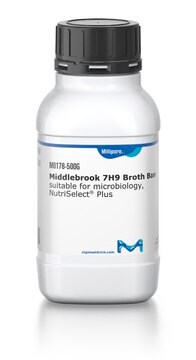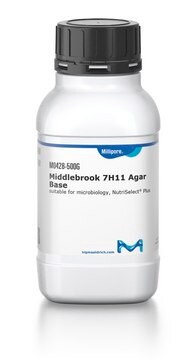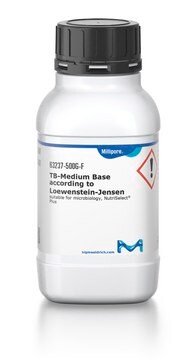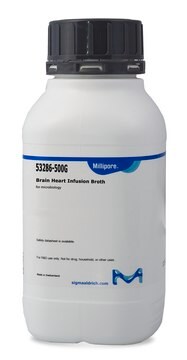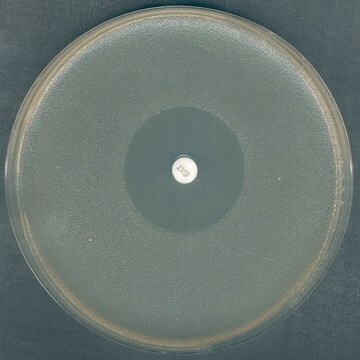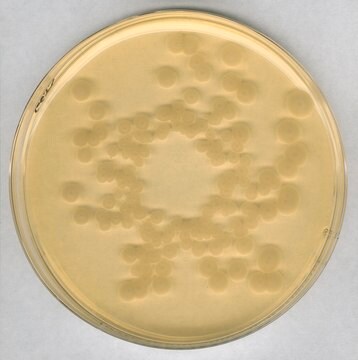M0303
Middlebrook 7H10 Agar-Basis
suitable for microbiology, NutriSelect® Plus, for use in isolation and cultivation of Mycobacterium species
Synonym(e):
Mycobacterial culture media
Anmeldenzur Ansicht organisationsspezifischer und vertraglich vereinbarter Preise
Alle Fotos(1)
About This Item
UNSPSC-Code:
41171609
NACRES:
NA.85
Empfohlene Produkte
Qualitätsniveau
Sterilität
non-sterile
Produktlinie
BioChemika
Form
powder
Haltbarkeit
limited shelf life, expiry date on the label
Verpackung
pkg of 500 g
Hersteller/Markenname
NutriSelect® Plus
Methode(n)
microbe id | susceptibility testing: suitable
microbiological culture: suitable
pH-Endwert
6.6±0.2 (25 °C)
Anwendung(en)
clinical testing
food and beverages
life science and biopharma
veterinary
microbiology
Eignung
mycobacteria
Verwandte Kategorien
Allgemeine Beschreibung
Middlebrook 7H10 Agar Base is recommended for isolation, cultivation and sensitivity testing of Mycobacterium tuberculosis. Middlebrook media consists of many inorganic salts, which help, in growth of Mycobacteria. Citric acid formed from sodium citrate helps in retaining inorganic cations in solution. Glycerol supplies carbon and energy. Middlebrook OADC Growth Supplement (M0678) contains oleic acid, bovine albumin, sodium chloride, dextrose and catalase. Oleic acid and other long chain fatty acids are essential for metabolism of Mycobacteria. Some free fatty acids are toxic to Mycobacteria, but albumin binds to those fatty acids and prevents toxic action on Mycobacteria. Dextrose serves as an energy source. Catalase neutralizes toxic peroxides. Malachite green partially inhibits other bacteria.
Anwendung
Middlebrook 7H10 Agar Base is a selective media for isolation, cultivation and sensitivity testing of Mycobacterium tuberculosis. Mycobacteria grow most rapidly in broth media and hence primary isolation of bacterial species can be carried out. It is inexpensive, easy to prepare and can aid in early detection of acid-fast, Mycobacterium species by culture.
Komponenten
Zusammensetzung (g/L)
Ammoniumsulfat, 0.50
L-Glutaminsäure, 0.50
Kaliumphosphat monobasisch, 1.50
Natriumphosphat dibasisch, 1.50
Natriumcitrat, 0.40
Eisenammoniumcitrat, 0.04
Magnesiumsulfat, 0.025
Calciumchlorid, 0.0005
Zinksulfat, 0.001
Kupfersulfat, 0.001
Pyridoxin-Hydrochlorid, 0.001
Biotin, 0.0005
Malachitgrün, 0.00025
Agar, 15.00
Ammoniumsulfat, 0.50
L-Glutaminsäure, 0.50
Kaliumphosphat monobasisch, 1.50
Natriumphosphat dibasisch, 1.50
Natriumcitrat, 0.40
Eisenammoniumcitrat, 0.04
Magnesiumsulfat, 0.025
Calciumchlorid, 0.0005
Zinksulfat, 0.001
Kupfersulfat, 0.001
Pyridoxin-Hydrochlorid, 0.001
Biotin, 0.0005
Malachitgrün, 0.00025
Agar, 15.00
Angaben zur Herstellung
Suspend 19.47 g of Middlebrook 7H10 Agar Base in 900 ml of distilled water. Add 5 ml of glycerol (Cat. No. 49767). Boil to dissolve the medium completely. Distribute in 180 ml amounts in erlenmeyer flasks and sterilize by autoclaving at 15 lbs. pressure (121°C) for 10 minutes. Cool to 45°C and aseptically add 20 ml of Middlebrook OADC Growth Supplement (Cat. No. M0678). Mix well and pour into screw capped tubes.Note: Keep prepared medium in the dark before and after inoculation.
Fußnote
We offer two media types: the superior granulated GranuCult® and the cost-efficient powdered NutriSelect® culture media, depending on your needs.
The designations basic, plus, or prime are added to indicate the quality control level, from basic quality control to standard QC plus to prime for full regulatory compliance.
The designations basic, plus, or prime are added to indicate the quality control level, from basic quality control to standard QC plus to prime for full regulatory compliance.
Rechtliche Hinweise
GRANUCULT is a registered trademark of Merck KGaA, Darmstadt, Germany
NutriSelect is a registered trademark of Merck KGaA, Darmstadt, Germany
Ähnliches Produkt
Lagerklassenschlüssel
11 - Combustible Solids
WGK
WGK 2
Flammpunkt (°F)
Not applicable
Flammpunkt (°C)
Not applicable
Hier finden Sie alle aktuellen Versionen:
Besitzen Sie dieses Produkt bereits?
In der Dokumentenbibliothek finden Sie die Dokumentation zu den Produkten, die Sie kürzlich erworben haben.
Kunden haben sich ebenfalls angesehen
Finegold, E.J., et al.
Bailey and Scott's Diagnostic Microbiology (1990)
Agreement of Middle brook 7H10 with Lowenstein Jensen and accuracy of the Sensititre MYCOTB plate using either method as a reference standard for Mycobacterium tuberculosis first line drug susceptibility testing
Ssengooba W, et al.
PLoS ONE, 13(6), e0199638-e0199638 (2018)
A biocide-free mineral oil nanoemulsion exhibiting strong bactericidal activity against Mycobacterium immunogenum and Pseudomonas aeruginosa
Chang SC, et al.
International Biodeterioration & Biodegradation, 70, 66-73 (2012)
Hyebin Song et al.
Cell systems, 12(1), 92-101 (2020-11-20)
Machine learning can infer how protein sequence maps to function without requiring a detailed understanding of the underlying physical or biological mechanisms. It is challenging to apply existing supervised learning frameworks to large-scale experimental data generated by deep mutational scanning
Ronald J Rieder et al.
Antimicrobial agents and chemotherapy, 53(11), 4598-4603 (2009-08-26)
Methods currently used for in vitro drug susceptibility testing are based on the assessment of bacterial growth-related processes. This reliance on cellular reproduction leads to prolonged incubation times, particularly for slowly growing organisms such as mycobacteria. A new rapid phenotypic
Unser Team von Wissenschaftlern verfügt über Erfahrung in allen Forschungsbereichen einschließlich Life Science, Materialwissenschaften, chemischer Synthese, Chromatographie, Analytik und vielen mehr..
Setzen Sie sich mit dem technischen Dienst in Verbindung.